Manuka honey is a special kind of honey that is only produced in New Zealand and is thought to have antibacterial, anti-inflammatory, and antioxidant properties that can help heal wounds and treat gastrointestinal problems.
Unlike normal honey, the presence of special proteins in manuka honey gives it a dark, caramel color and a richer flavor than other kinds of honeys or sweeteners.
These proteins and other biologically active compounds from the New Zealand bees that make this honey are what grant it the health benefits that it’s known for.
Finding quality manuka honey can be tough—with its rapid growth in popularity, there are some unscrupulous venders who sell manuka honey that’s adulterated with syrup, and not all manuka honey products have the same potency.
Fortunately, our research team has ranked and reviewed the best authentic manuka honey on the market.
Research
Rankings
1. Wedderspoon Raw Manuka Honey
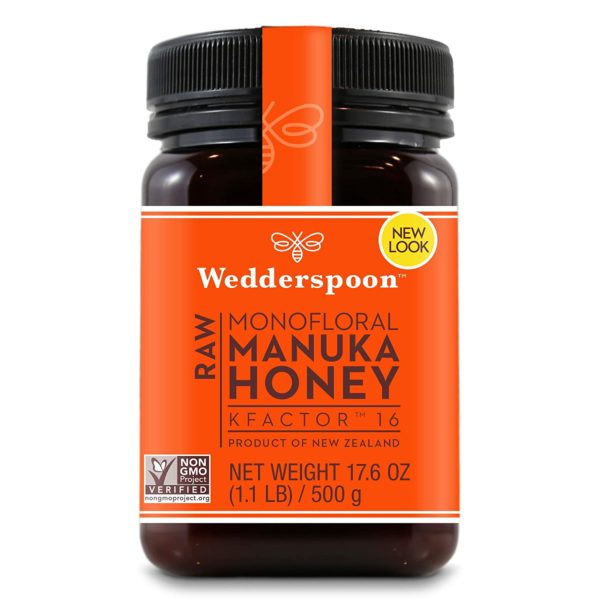
Wedderspoon Raw Manuka Honey is unpasteurized and guaranteed that at least 75% of its pollen count is from the manuka tree.
It’s imported directly from New Zealand, and users find it particularly useful for infections, illnesses, and stomach problems. At almost 18 ounces per container, one jar is going to last you quite a while.
Thanks to its purity and size, it’s our top pick.
2. Manuka Doctor
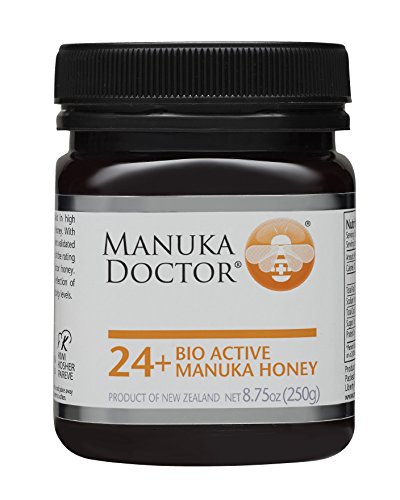
Manuka Doctor is harvested in Auckland, New Zealand, and imported straight to the US. It’s a favorite of apitherapy enthusiasts, who use products like raw honey and royal jelly to treat a range of physical and mental ailments.
The 8.75 ounce jar is convenient for occasional users and people who don’t want a full pound of honey, or more, sitting around.
3. Kiva Manuka Raw Honey
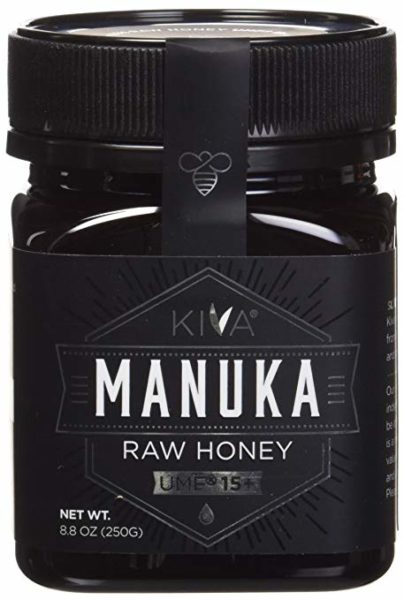
Kiva Manuka Raw Honey comes in a medium-sized 8.8 ounce jar and is sourced from the more remote coastal regions of New Zealand. It’s especially popular among people using it to treat blisters, infections, and wounds.
4. 100% Pure New Zealand Honey Manuka

This manuka honey product is well-liked by its users for its anti-inflammatory properties and its antibacterial potency. It scores well on chemical tests of antioxidant potency, which explains its success at treating inflammatory conditions.
5. Manuka Health Manuka Honey

Manuka Health Manuka Honey is a honey that comes in an 8.8 ounce jar and is touted for its methylglyoxal content, which the company claims is the key ingredient in manuka honey.
However, it’s more likely that the key factor is a combination of the different proteins, pollens, and other bioactive compounds, so the utility of focusing on just one ingredient might be questionable.
6. Pacific Resources International Manuka Honey

Pacific Resources makes an extra-large 1.1 pound jar of manuka honey. It has pretty solid biological activity, as measured on standardized chemical tests, but not the best.
If you are using manuka honey for cooking or for regular daily consumption, though, it’s hard to beat given the large volume of manuka honey per container.
7. Manukora Raw Manuka Honey
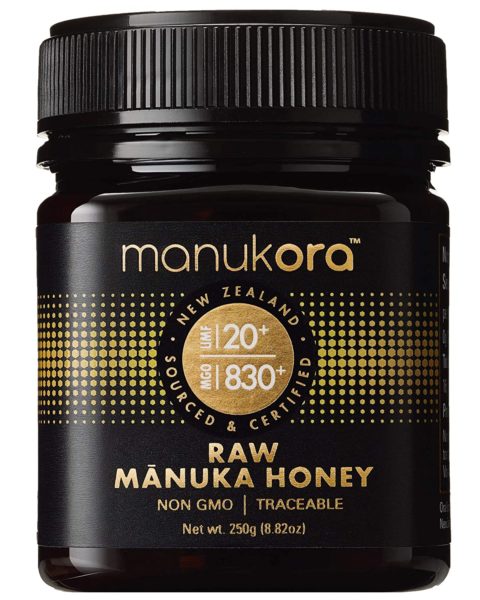
Manukora is a small but potent manuka honey that prides itself on its exceptionally high UMF and MGO scores. It’s perfect for occasional users, though the smaller size of 8.8 ounces might be a bit small for real enthusiasts.
8. Dr. Nordyke’s Wound Honey
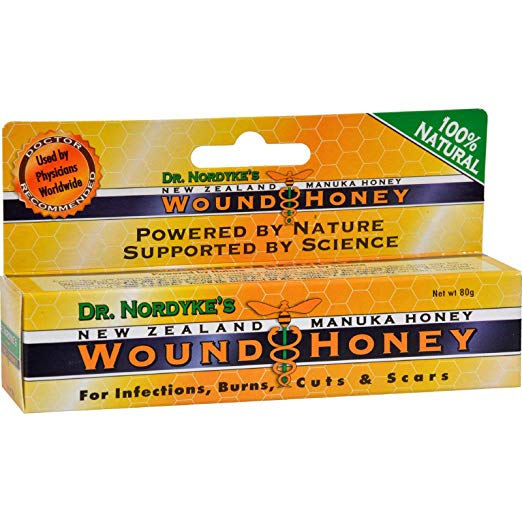
Dr. Nordyke’s Wound Honey is a small-sized manuka honey that comes in a 2.8 ounce tube. It’s specifically designed for healing wounds, but the primary downside to this supplement is that its biological activity rating is lower than many of its competitors, which is exactly the opposite of what you’d want in a manuka honey that was specifically made for wound treatment.
9. Trader Joe’s Manuka Honey
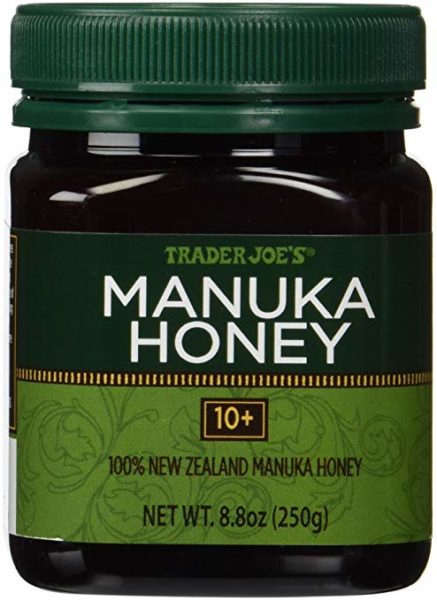
Trader Joe’s Manuka Honey is sourced from New Zealand, but the specific region this manuka honey comes from is not disclosed.
It’s outclassed by some of its competitors when it comes to the concentration of manuka pollen in the honey, but it’s still a pretty solid 100% manuka honey product.
10. Comvita Manuka Honey

Comvita Manuka Honey comes with a high UMF rating, meaning its antioxidant potency is strong, as measured by a standardized laboratory test.
Some people find that the bottle doesn’t deliver quite the promised 8.8 ounces, though, so it might be better to steer towards a different manufacturer to make sure you’re getting the promised amount of honey.
Category winners
Best manuka honey overall: Wedderspoon Raw Manuka Honey
Wedderspoon takes our overall top spot thanks to its high purity and the high quantity of manuka honey per jar. It’s great for steeping tea, treating wounds and scars, soothing an upset stomach, and a wide range of other uses as well.
Best manuka honey for stomach problems: Wedderspoon Raw Manuka Honey
Wedderspoon’s authentic New Zealand manuka honey has strong antioxidant and antibacterial activity and has zero additives, making it great for calming an upset stomach either on its own or as an ingredient in tea.
Best manuka honey for acne and scars: Kiva Raw Manuka Honey
Kiva Raw Manuka Honey scores highly on tests for antioxidant and anti-inflammatory activity, which means it is perfectly suited for tackling the inflammation and oxidative damage that occurs with acne, scars, and other skin problems.
Best manuka honey with antibacterial properties: Manuka Doctor
For fighting bacteria, having a high Unique Manuka Factor (UMF) is key. That’s why we recommend Manuka Doctor, which ranks highly on both the UMF score and the similar MGO score. Its potency makes it a great pick for fighting bacteria.
Best manuka honey for tea: Kiva Raw Manuka Honey
To soothe sore throats and congestion, manuka honey is a great addition to any kind of tea. We like Kiva Raw Manuka Honey for this purpose due to its high UMF rating and stringent raw sourcing.
Best manuka honey for wounds: Manuka Doctor
Manuka Doctor’s high antibacterial activity makes it a good natural remedy for wounds, and its thick consistency and high purity means the active ingredients aren’t too diluted to promote wound healing.
Who should buy manuka honey?
Manuka honey is safe for most individuals and is a great alternative to regular honey or other sweetness. Due to its antioxidant and anti-inflammatory prowess, it is also a powerful cream and wound healing agent. Persons suffering from acne will also see benefits from using manuka honey.
Children under the age of 2 years should not consume manuka honey under any circumstances.
How we ranked
When ranking the best manuka honey, we mainly looked at the rating. There are 3 main ratings: UMF, MGO, and KFactor. The Unique Manuka Factor (UMF) is the internationally recognized gold standard rating system for assessing authenticity, purity, and quality, purity. It’s governed by the UMFHA (Unique Manuka Factor Honey Association).
The UMF certification system has two elements. First, it confirms the product in question is genuine. Second, it assigns a number (known as the UMF number) that indicates the level of key beneficial compounds present in the manuka honey. UMF strength can range from 5+ to 20+, with a higher rating indicating the most potent product.
The UMF rating also measures the amount of NPA (non-peroxide antibacterial activity) present in the honey, which is directly related to each other (if a Manuka honey has an NPA of 20, then it will be UMF 20+). For our rankings, we required a minimum UMF rating of 5 but ideally wanted products like Kiva Raw Manuka Honey with a UMF of 15 or higher, since most studies have been done with this UMF level.
MGO stands for methylglyoxal, which is a chemical that naturally occurs in Manuka honey. It was discovered by Professor Thomas Henle and is considered the magic ingredient that makes Manuka Honey so powerful For our rankings, we required all products, like Manuka Doctor, to have an MGO of at least 80, but ideally more.
The KFactor grading system is quite different than UMF and MGO since it measures markers such as live enzymes, DHA, pollen count, pH levels, antioxidant levels, and phenolic compounds.
Unfortunately, it does not measure MGO, NPA, or leptosperin levels, which makes it a little less reliable in terms of determining purity and potency. For our rankings, we required all products to have a KFactor of 16 or more, like our top pick Wedderspoon.
Manuka honey is often labeled as “active Manuka honey,” which refers to the antibacterial effects produced by hydrogen peroxide. This is misleading since all honey, manuka, or not contains this.
Any product that was not 100% manuka honey was immediately axed. Furthermore, since the manuka plant is native to New Zealand, any product not from there was eliminated as well.
Benefits
Manuka honey is a powerful herbal remedy that can only be found in New Zealand. Manuka honey is a type of bee honey that can only be produced in New Zealand, and thanks to the high concentrations of antioxidants, proteins, and pollens, it’s a common herbal remedy.
People use it to treat infections, skin conditions, gastrointestinal problems, and inflammation problems. Apitherapy practitioners, who use ingredients like honey, bee pollen, and royal jelly for medicinal purposes, are avid consumers of manuka honey.
Some people apply it directly to their skin, while others mix it in with tea, smoothies, or protein shakes as a superfood to increase their antioxidant status. What’s the scientific research say about manuka honey? We’ll take a look.
Manuka honey shows strong antibacterial activity. Honey is known for its antibiotic properties to begin with—that’s why honey reportedly has no expiration date.
But manuka honey seems to be particularly effective at fighting off pathogens, and it’s been studied for this ability in scientific studies.
One such experiment was described in the Journal of Applied Microbiology by two researchers at the University of Waikato in New Zealand (1).
The experiment involved testing how long various strains of infectious bacteria would be inhibited different concentrations of manuka honey. They studied seven different types of bacteria, all of which are common infectious agents in wounds in humans.
The results showed very promising results for the manuka honey solutions. Staph bacteria, for example, was inhibited completely for eight hours at manuka honey concentrations of only 1.8%.
The efficacy at this low concentration helps make a case that manuka honey could be useful beyond just the surface-level application on the skin.
As the active compounds of manuka honey diffuse out into a wound or into your body, they necessarily get more diluted, but this study indicates that even when diluted more than fifty-fold from full-strength, manuka honey retains strong antibacterial activity.
Manuka honey is more effective at fighting infection than regular honey. Though the effects of manuka honey are impressive, regular honey also shows antibacterial effects. Is manuka honey any better?
A scientific study published in 1999 in the Journal of the Royal Society of Medicine sought to answer this question (2).
The experiment focused specifically on the bacteria Staphylococcus Aureus, which is of particular medical interest thanks to its propensity to develop resistance to conventional antibiotics.
The experiment involved testing 58 different strains of Staphylococcus Aureus bacteria in a range of concentrations of both regular honey and manuka honey.
The results showed that pretty much all of the bacterial strains were inhibited in regular honey concentrations of 3-4%.
Manuka honey, on the other hand, required only a 2-3% concentration to inhibit the bacterial growth, which suggests that it contains particularly effective anti-bacterial properties, even compared to regular honey.
Some researchers attribute this to a property that is called “non-peroxide antibacterial activity.” One study published in the journal Food Chemistry in 2004 used a variety of chemical techniques to neutralize hydrogen peroxide, one of the antibacterial compounds that’s found in both regular honey and manuka honey (3).
Even after neutralizing the hydrogen peroxide, the remaining compounds in manuka honey show strong antibacterial tendencies, suggesting that there is something special about the compounds in the manuka tree pollen or flowers that grants manuka honey its unique properties.
Manuka honey can be used to improve inflammation-related gastrointestinal problems. People who suffer from inflammatory bowel syndrome (IBS) and related diseases like Crohn’s disease often find manuka honey helpful for reducing the severity of their symptoms.
There are a few possible scientific explanations for this. One possibility is that manuka honey is improving the quality of the gut flora, thanks to selective antibiotic effects that kill off bad bacteria and allow the good ones to thrive.
This hypothesis was forwarded by a study published in 2006 that used honey to alter the gut bacteria of lab mice (4). The study showed that prolonged consumption of honey was able to reduce the levels of harmful bacteria and fungi in the gastrointestinal tracts of the mice.
Other research in animals has proposed, instead, that manuka honey induces an anti-inflammatory and antioxidant reaction. One such study published by researchers in India showed that manuka honey was able to play a beneficial role at reducing the severity of an animal model of ulcerative colitis, another inflammation-related gastrointestinal problem (5).
Whatever the biological reason, there does seem to be at least circumstantial evidence that manuka honey can play a beneficial role in regulating gastrointestinal health, either by promoting probiotic growth and suppressing “bad” bacteria, or by the direct reduction of inflammation and oxidative damage.
Side effects
Manuka honey is not known to have any direct adverse effects, either when taken orally or when applied to the skin.
Like any plant-material containing supplement, there is a slight possibility of an allergic reaction, but aside from this, the only risks associated with manuka honey are the consequences of not seeking treatment for something you ought to see a doctor about.
While manuka honey does have antibacterial and anti-inflammatory properties, it’s not a cure for everything, so if you have a wound, sore, or other medical problem, you should still consult your doctor.
When taken orally, the only additional adverse effect to worry about is the sugar content, but you’d have to eat a low of manuka honey for the sugar content to start playing a major role in your overall dietary sugar intake.
Recommended dose
Few studies have prescribed exact doses, likely because much of the scientific research focuses on the cellular effects of manuka honey, so it’s not easy to translate these findings to tangible doses.
For treating an area topically (on your skin), using just enough manuka honey to get good coverage of the affected area should garner the best results.
Taking manuka honey orally for gastrointestinal problems is in more of a gray area when it comes to dosage, because there’s no clear guidelines from the scientific research.
Some findings suggest that low doses (only a few grams at a time) can be effective, while other research makes the case that you won’t see benefits unless your intake is very high (50 to 80 grams of honey at a time) (6).
The best approach is probably to start with a small dose, say 5-10 grams, and ramp up if you are not getting the results you want.
FAQ
What’s so special about Manuka honey? Unlike many fad diets and supplements, manuka honey has actually been linked to positive health benefits when used as recommended. The most substantial benefit of manuka honey is its ability to heal wounds and treat infections. Not only does the honey prevent the spread of infection, but it also helps the tissue to regenerate and heal the wound overall.
Due to the antibacterial abilities of manuka honey, there is also a connection between consuming the honey and a reduced amount of bacteria in the mouth, which could result in greater dental health. Manuka honey can also provide treatment to sore throats and throat infections. There is also evidence that manuka honey has a decent level of antioxidants in every serving. So, in addition to being able to treat current infections and conditions, manuka honey may be able to help you prevent diseases and illnesses in the long-term.
What is the difference between manuka honey and regular honey? The difference between manuka honey and regular honey is the source of nectar used to in the making of the honey. When producing regular honey, bees pollinate local flowers and produce the honey in their beehives. The flowers used in this process vary, and the end goal is to just create honey. However, manuka honey is created from the nectar of the manuka plant, which is native to New Zealand.
Is it easier to make manuka or regular honey? It is much easier to produce regular honey than manuka honey. This is because regular honey has fewer requirements (does not need a specific flower) and also can be produced worldwide rather than where the manuka plant is (New Zealand).
Why is Manuka honey so expensive? There are several reasons that manuka honey is so expensive, and all relate to the difficulty of cultivating the honey. Most significant is the fact that manuka honey is not regular honey and the only way to retrieve manuka honey is to guarantee the bees creating it are pollinating the manuka plant.
Unlike regular honey, manuka honey cannot be harvested all year round. This is due to the fact that the manuka plant only flowers for a few weeks every year, severely limiting the potential supply of the honey, as compared to regular honey. There is a significantly lower supply of manuka honey, which, in turn, causes a higher value.
The final reason for the elevated price tag of manuka honey is the actual location in which the honey is produced. Because manuka honey is only really found in New Zealand and Australia, this requires extra work to cultivate the honey and a higher cost to ship the honey worldwide.
Why is manuka honey so healthy? Manuka honey is healthy because of its antibacterial and anti-inflammatory effects. Not only can you use the honey in your tea or as a replacement for regular honey in food recipes, but you can also use the substance to treat wounds and reduce infection within the body.
There are also antioxidants found inside manuka honey, which can help you fight infections and diseases. Because manuka honey is a byproduct of the nectar from the manuka plant, it would be accurate to assume that the benefits of manuka honey are as a result of the manuka plant.
How much manuka honey should you eat a day? If you’re looking to receive the maximum amount of health benefits from manuka honey, 1-2 tablespoons per day is recommended. In the case of manuka honey, more may be better, but it can get both costly financially and metabolically as it is not a calorie-free food.
Is manuka honey worth the hefty price tag? If you’re simply looking to add honey to your tea or other food, the price of manuka honey likely isn’t worth it. However, if you are interested in consuming manuka honey for the health benefits or you’re looking to use the honey on your skin to treat skin conditions and wounds, manuka honey may be worth the extra cost.
What does manuka honey taste like? Many describe the flavor of manuka honey as somewhat bitter, while others believe manuka honey tastes relatively sweet. The taste of the manuka honey varies depending on the UMF score of the honey itself. UMF is a way of rating the potency of manuka honey with low grades having lower scores and high grades having a score of 16 or more.
How can you use manuka honey? Manuka honey is popular both as a food additive and an all-natural medicinal treatment. You can use the honey on the surface of the skin to treat mild infections and wounds or reduce inflammation in skin conditions. The manuka plant also has several uses other than its honey. When consumed or inhaled, manuka products have been shown to reduce the severity of head colds, lower fevers, and treat muscle stiffness and joint aches. Overall, the manuka plant is highly beneficial as a treatment method for many health concerns and conditions.
Where can you buy manuka honey? If you’re looking to buy manuka in a store, you’ll likely have to go to a specialized health and wellness store to find it. A majority of the locations that sell manuka honey are online stores that specialize in herbs or are mainstream retailers like Amazon.
Unlike regular honey, you cannot just go to your local beekeeper or farm to purchase the product because manuka honey comes from New Zealand and is not produced anywhere in North America. Anyone trying to sell you manuka honey from the United States or Canada is selling you a false product.
What is the best way to store manuka honey? The best way to store manuka honey is in a cool, dry location. Manuka honey, like regular honey, can essentially last forever when stored properly.
Is manuka honey good for the skin? Though not studied in-depth as of yet, there is a possibility that manuka honey can be useful for the skin and even treat common skin conditions. The most common condition treated with manuka honey is acne, with those using it experiencing reduced inflammation of the skin and less debris on the face.
When using manuka honey on your skin, you can use it to wash the skin or use it as a face mask of sorts. Manuka honey may also improve moisture retention in the skin, but more research is needed to confirm this.
Does manuka honey come from manuka flowers? Manuka honey comes from the manuka flowers of the manuka plant. However, the plant itself does not produce the honey, but rather bees that pollinate the plant. When bees collect the nectar from the manuka flower, they used the nectar to create honey within their beehive.
Does manuka honey kill bacteria? Regular honey has been used as a wound-healing agent and antibacterial solution for thousands of years. After manuka honey became increasingly more popular in the last several years, scientists began researching similarities between regular honey and manuka honey.
After testing manuka honey as an antibacterial treatment for bacterial infections, scientists discovered that manuka honey is quite effective at destroying bacteria in humans. In particular, manuka honey reduces the number of bacteria at the wound site and even prevents further growth of bacteria in the body (7, 8).
Other studies went into significantly more detail, recognizing that not only did manuka honey reduces the growth of bacteria, but it also sped up the wound healing process and assisted with tissue regeneration during healing (9).
Many medical professionals and scientists agree that manuka honey is a viable option if you are looking to treat bacteria in wounds. However, you should monitor the severity of the wound and determine whether or not manuka honey (as opposed to antibiotics or other medication) is the best option for your wound.
Is manuka honey safe for young children? If the child is over the age of 18 months, there should be no concern when it comes to the child consuming manuka honey. Like regular honey, there is a risk associated with giving manuka honey to your child, particularly an increased risk of botulism. While this bacteria does not cause issues in the average person, a young child with a still-forming immune system may be unable to fight this bacteria. This disease is potentially fatal in infants and young children, which is why it is recommended that you avoid giving honey to your toddler 18 months and younger.
What is manuka? Manuka honey is a product that comes from the flowering manuka plant. The plant is native to the areas of Australia and New Zealand, but the products made from the plants are utilized worldwide. Though most popular for its honey, the manuka plant is also responsible for products that assist with the treatment of head colds, burns, and muscular pain.
Can manuka honey be used to treat infections? Though you shouldn’t depend on manuka honey to cure a severe infection or heal a wound quickly, a lot of research has determined that manuka honey is effective in the treatment of infections and wound healing.
If you’re interested in using manuka honey to treat an infection, you should make sure that the infection and wound are not extremely serious and do not require powerful antibiotics to treat them fully.
When applied to a wound, manuka honey helps to rid the wound of harmful debris, keep the wound hydrated to enhance healing, and reduce the amount of inflammation in the wound and the surrounding area (10).
Is manuka honey raw? Raw honey is any honey that comes directly from the beehive without any additives and processing. Generally speaking, manuka honey is not raw and does go through processing at some point before being sold.
Related Articles
Recap
Manuka honey is a special type of honey that has particularly strong antibacterial effects. Many people capitalize on these properties to use manuka honey on wounds, sores, infections, and blisters.
It’s also a strong antioxidant and anti-inflammatory agent, which has led to its use in improving gastrointestinal problems related to intestinal inflammation.
It’s very well-tolerated, with no reported adverse effects. When applying manuka honey to your skin, a medium-thickness layer of honey over the affected area is an effective “dosage.”
For internal use, dosing recommendations vary widely, but starting with 5-10 grams and increasing over time if you do not see the results you’d like is a smart approach to take.
Thanks to a unique combination of the chemical properties of the manuka tree and the biological process that takes place when its nectar is turned into honey, you can capitalize on the benefits of manuka to treat wounds, fight infections, and have better gastrointestinal health.
For BodyNutrition’s #1 manuka honey recommendation, click here.